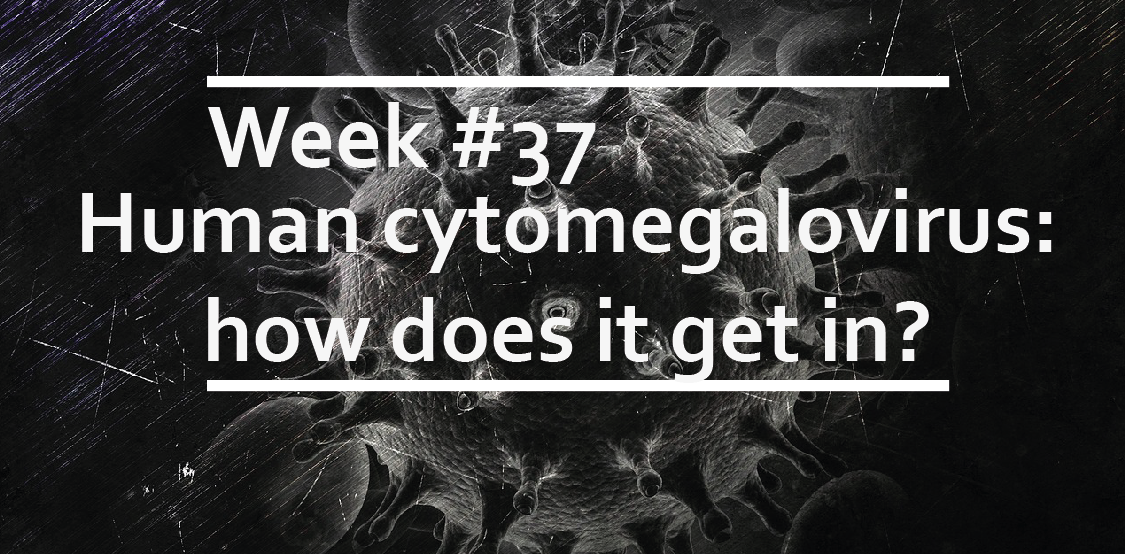Human cytomegalovirus: how does it get in?
HCMV: the problem
Human cytomegalovirus (HCMV) infects between 50% and 100% of the human population, depending on the geographical location. Generally infection doesn’t cause major complications, but the virus remains latent in various sites in the body and can be reactivated at any time. For immune compromised people including transplant patients, HCMV represents a serious life threat, and it is also responsible for congenital birth defect when contracted during pregnancy.
While few drugs targeting viral replication are available, their effectiveness and safety remain suboptimal.
HCMV: the tropism
HCMV is a double stranded DNA virus from the Herpesviridae family.
It has a very broad tropism, infecting epithelial and endothelial cells, fibroblasts, monocytes and macrophages, neurons and stromal cells, as well as smooth muscle and hepatocytes.
Entry into these cells is mediated by different proteins on HCMV surface. Two gHgL- containing complexes mediate virus tropism: 1) gHgLgO (trimer) is required for infection of fibroblasts; and 2) gHgLpUL128-131A (pentamer) mediates entry into epithelial, endothelial and myeloid cells. But what do these viral complexes bind to? The trimer has been shown to bind the PDGF receptor alpha on the surface of fibroblasts, but the receptor for the pentamer (which is also the main target of neutralising antibodies) has not been identified.
A clever way to identify receptors
Receptor identification is a major challenge in virology, as it is difficult to detect low affinity interactions with low abundance receptors in the harsh conditions required to isolate proteins.
To get around this problem, Martinez-Martin and colleagues used bioinformatics and manual curation to design a library inclusive of nearly all surface expressed single transmembrane (TM) human receptors (1297 proteins), cloned as extracellular domains fused to the C-terminus of human IgG1Fc. Fusion to an IgG allowed for transient expression into human cells and release of soluble receptors into the supernatant, which was then collected and immobilised onto protein-A coating plates.
The viral pentamer and trimer were also engineered to be tagged to a reporter, by replacing the single TM region at the C-terminus of gH (which inserts these proteins into HCMV) with the cartilage oligomeric matrix protein (COMP) scaffold conjugated to a beta-lactamase reporter. This oligomeric structure allows for oligomerisation of the viral proteins, and this enhances avidity for the receptor, enabling detection of both stable and transient interaction.
These viral structures were then just added to the soluble receptors coated plates, and the interaction detected by colorimetric substrate turnover.
What is the HCMV pentamer receptor?
This strategy confirmed an interaction between the trimer and PDGFRalpha, validating the screening strategy, and also pulled out TGFbeta receptor III and NRG2. The pentamer was instead seen to interact with Neurophilin 2 (Nrp2), Thrombomodulin (THBD), LILRB3, and FCAR.
Biolayer interferometry confirmed the interactions of the trimer with PDGFRalpha and TGFbetaRIII (but not with NRG2, suggesting that this interaction is transient and very low affinity, detectable only upon oligomerisation), and of the pentamer with Nrp2, THBD, and LILRB3 (but not with FCAR). CD46, a previously reported binding candidate, also showed some weak interaction.
Flow cytometry confirmed expression of CD46, Nrp2, and TGFbetaRIII in epithelial cells, HUVEC, and fibroblasts, while PDGFRalpha and THBD were only expressed in fibroblasts and HUVEC, in line with trimer and pentamer tropism.
Consistently, recombinant soluble Nrp2 as well as Nrp2 targeting antibodies inhibit HCMV infection in dose-dependent manner, but only in cells that do not express PDGFRalpha, where entry is mediated by the viral trimer.
Together these data are consistent with a model in which Nrp2 interacts with the pentamer in epithelial and endothelial cells, and PDGFRalpha interacts with the trimer in fibroblasts. Overexpression, siRNA, and rescue experiments confirmed the requirement for these receptors in HCMV entry, and suggested that other like CD46, THBD, and TGFbetaRIII are likely to be not essential. Consistently, the higher susceptibility of fibroblasts to HCMV infection is likely to be due to the expression of both receptors, which makes these cells permissive to both trimer and pentamer-mediated infection.
By negative stain EM, single particle analysis, and chemical crosslinking on the pentamer-Nrp2 complex, the authors find that individual domains of Nrp2 interact with distinct regions of the pentamer, and this interaction induces conformational changes. In particular, the N-terminal region a1 of Nrp2 appears to be more important then the MAM C-terminal region for the interaction with the pentamer.
They also find that most neutralising antibodies compete for the Nrp2-pentamer interaction, further highlighting the importance of Nrp2 as HCMV receptor.
Where does this finding take us?
While this screening only explored interaction with single TM containing receptors, it is possible that more receptors can be found amongst the multi TM proteins at the cell surface, however this study demonstrate that Nrp2 is required for optimal infection through HCMV pentamer.
Another interesting consideration is that upon ligand binding, Nrp2 is directly involved in in the endocytosis of different molecules. Although the authors don’t explore whether endocytosis is activated upon binding of the HCMV pentamer, they suggest the possibility that while the trimer is responsible for virus fusion with the plasma membrane, the interaction of the pentamer with Nrp2 may trigger a different mechanism of virus internalisation through endocytosis.
This work opens up several interesting lines of research, with important consequences toward the development of new therapies against this potentially very dangerous virus.




